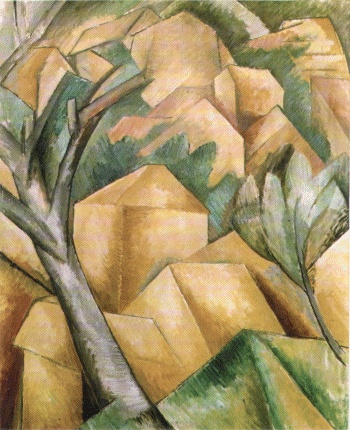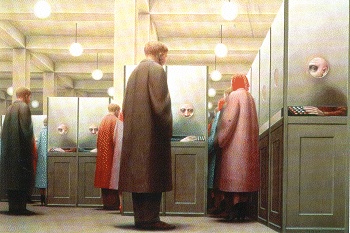
|

(Assignments see at the bottom)
 |
Edward Hopper's 'Nighthawks' (1942) is not only an image of big-city loneliness, but of
existential loneliness. The painting conveys a mood of loneliness and desolation by their emptiness or by the presence of
anonymous, non-communicating figures.Although the downtown cafe or diner is well-lit, it doesn't suggest offering hospitality. There is not even a door
to enter it. The customers inside seem to be exposed and vulnerable. The single man on the left observing the couple might be
a model of Hopper himself. The couple doesn't seem to communicate with each other, but rather with the man behind the counter.
All three guests are seemingly lost in their own thoughts.
Hopper himself described this work as a painting of 'three characters'. The man behind the
counter, as if imprisoned in the triangle, is in fact free. He at least has a home and a job he can fall back on. Are the three guests
imprisoned in a glasshouse, dependent from the outside world?
'Nighthawks' is on display at the Art Institute of Chicago, it is an oil on canvas work and Hopper's most popular one.
Hopper explained that Nighthawks was inspired by "a restaurant on New York’s Greenwich Avenue where two streets meet."
He is considered as the best painter of modern American life. His painting are of amazing realism, pieces of everyday life in
cities, towns, villages and all sorts of surroundings.
|
 |
 |
A Midsummer Night's Dream by Marc Chagall, 1939
Small fairies fly around as Bottom, the weaver, embraces their Queen, Titania, in Chagall's vision of Shakespeare's
'A Midsummernight's Dream'. The world of magic, fantasy and the unreal were spheres in which the Russian-Jewish artist felt at home.
Chagall's work is often playful and fanciful, but its charming fairy-tale quality must not distract the viewer from the fact
that it often dealt seriously with the great tragedies of existence.
The small red devil or fairy is the most dynamic image in the composition as she gestures and seems to be encouraging
the romance.
Chagall's works are difficult to categorize within the history of modern art. He took part in the movement
of the Paris art world before World War I and was thus involved with avant-guard currents. However, his work
always found itself on the margins of these movements and emerging trends, including Cubism and Fauvism. He was closely
associated with the Paris School and its exponents. |
Houses at L'Estaque by Georges Braque, 1908
Georges Braque was the co-founder of Cubismus along with Pablo Picasso. Some of their works are almost indistinguishable.
Louis Vauxcelles, a critic of Braque, stated that Braque despises form and reduces everything, landscape and figures and
houses, to geometric patterns, to 'cubes'. The details in this painting may be disregarded, as there are no doors or
windows in the houses, no leaves on the trees. Braque does not even distinguish between the houses and the hills that surround
them, yet he makes serious efforts to give a sense of reality in terms of palpable mass and three-dimensional depth. |
 |
 |
Government Bureau, 1956 by George Tooker
The eerie effect of this painting is achieved by replication: more or less identical members of the public queuing
up before more or less identical windows to be directed by more or less identical officials. The scene is a typical New York
local government office with its rectangular pillars and ceiling supports. Government is strictly demarcated
from the public it nominally represents, its clerks half-glimpsed behind distorting glass. Their hands are visible,
poised over the call buttons ready to summon the next client. Anonymous faces look through the porthole onto lines of equally
anonymous men and women dressed like newly arrived immigrants. The stooped figure in the foreground seems to be cut of from the outside world. he conveys isolation
and alienation; social conformity leaves the individual abandoned. It is a simple work, without the exotic or the overstated about it, yet
the impression it makes could hardly be more powerful.The painting expresses impersonal demands of beaurocracy and its
dehumanizing effects on individuals, who have neither comprehension nor control as they wait to be processed. It is a
commentary of the misuse of authority and may have resullted from Tooker's own experience of dealing with local government
over a proposed planning application for the rooming house in which he lived. |
Les Demoiselles d'Avignon by Pablo Picasso, 1907
The setting for this painting was Avignon Street , notorious as the centre of Barcelona's early 20th century red
light district. Accordingly the ladies are young whores. The fruit in the foreground is forbidden, and the women
almost seem to be daring the viewer to taste it. None of the five figures is conventionally feminine, all slightly menacing, and each
is rendered with angular and disjointed body shapes. Two of the women are rendered with African mask-like faces,
giving them a savage and mysterious aura.Cubist theory would suggest intellectualized sterility, but the movement's
founders, Picasso and Braque, were striving for more vividness, and not less. In this painting Picasso succeeded in
expressing vividness in spite of the abstractness of cubism. This is due to Picasso's extraordinary talent.
|
Assignments:
1. Ref. 'Nighthawks'
Do you think there is a contradiction between life in a big city and people being lonely?
2. Ref. 'A Midsummer Night's Dream'
Men or women and a world of fantasy have been a theme in art and literature since long. Can you name one or two other examples
of such theme and explain why people are attracted by fantasy creatures?
3. Ref. 'Houses at L'Estaque'
Which are the typical features of Cubism in this painting?
4. Ref. 'Government Bureau'
What does Tooker want to convey to the viewer by his painting? Do you think that a disturbing situation as depicted in this painting
could occur in today's America?
5. Ref. 'Les Demoiselles d'Avignon'
Would this painting have attracted more viewers if it had been painted in a more graphic and picturesque manner?
|





